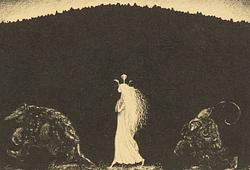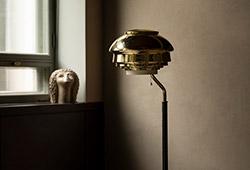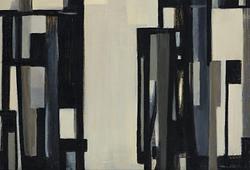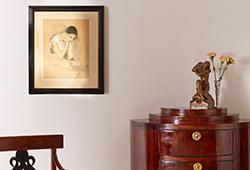Gösta Adrian-Nilsson
"Farväl till Maimuna (Sjömansvisa)"
Signed GAN. Executed in the 1920s. Canvas 61 x 46 cm.
Provenance
Acquired by the current owner's father, probably in the 1940s.
More information
Gösta Adrian-Nilsson (GAN) has, like few other Swedish artists, forged his path and challenged the norms of his time. One way he did this was by choosing to use masculine sailors as subjects for his paintings, which led to his art being seen as a form of 'protest art' and as an expression of his homosexuality. It should be noted that this was in the early 20th century, a time when homosexuality was still taboo and illegal in Sweden. Using sailors as subjects was also a way for GAN to illustrate his own desire to experience other parts of the world that were foreign to him by virtue of both his environment and his culture. GAN was not able to travel as often or as far as he wanted, but through his work, he took the viewer on journeys to distant places such as Samoa in Polynesia.
From 1920 to 1925, GAN lived in Paris, with breaks in the summers of 1922 and 1923 for stays in Lund and Halmstad. In October 1921, the musician Matti Rubinstein gave him a small two-room apartment at 86, rue Nôtre-Dame-des-Champs in Montparnasse. In the same building, Fernand Léger had his studio and later on the street level his famous school, the Académie Moderne. GAN, who was already moving away from his 'kaleidoscopic' cubism towards a synthetic cubist style around 1919/20, made contact with Léger during his first summer in Paris in 1920, who kindly welcomed him into his studio and a collegial exchange of ideas developed.
Although GAN took certain influences from Léger, the synthetic cubist style he developed in Paris is quite different from Léger's austere 'machine cubism'. GAN's cubism is more detailed, varied and dynamic, and in the early 1920s he reintroduced human figures such as athletes, soldiers and sailors into his work. GAN would return to more abstract expressions towards the end of the 20th century, when he also engaged in surrealist experiments. One of his main strengths was his ability to draw inspiration from a variety of expressions without ever resorting to imitation.
The auction's painting 'Farewell to Maimuna (Sea Song)' is an outstanding example of how GAN's individualistic artistic experimentation took shape. The work's powerful composition and strong, contrasting yet harmonizing color scheme combined to embody his expressive style. In the scene, the viewer encounters the sailor bidding farewell to his beloved Maimuna in the classic sailor's song 'Adieu To Maimuna'. The composition takes the viewer on a journey that unites new worlds.
Artist
Gösta Adrian-Nilsson is most notable as a visual artist, and he is a pioneer of Swedish modernism. He studied at the Tekniske Selskabs Skole in Copenhagen and later for Johan Rohde at Zahrtmann’s school in Copenhagen. As an avant-gardist, Nilsson was constantly searching for new influences. In Berlin, he was influenced by the circle around the radical magazine Der Sturm, through Kandinsky and och Franz Marc. In Paris through Fernand Legér and the artists in his circle. GAN was an eclectic in the positive sense of the word. He took the the artist styles of the 1900s and created new impressions. Symbolism, cubism, futurism, expressionism, constructivim and Theosophy were the colours occupying his internal pallet. He had a sharp eye for the masculine and his painting was often energized by the vitality of modern technology, vibrant eroticism, and echoes of tyrants. No other Swedish modern artist exhibits such a unique style.
Read more























































